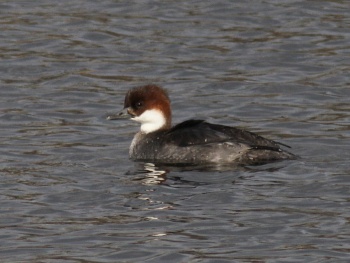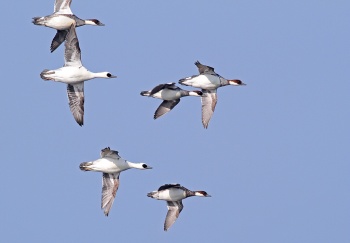(Flight picture. References updated) |
(→External Links: New combined GSearch. GSearch checked template) |
||
| Line 42: | Line 42: | ||
{{ref}} | {{ref}} | ||
==External Links== | ==External Links== | ||
| − | {{GSearch|Mergellus | + | {{GSearch|"Mergellus albellus" {{!}} "Smew"}} |
| + | {{GS-checked}} | ||
| + | <br /> | ||
<br /> | <br /> | ||
| − | |||
| − | [[Category:Birds]] [[Category:Mergellus | + | [[Category:Birds]] [[Category:Mergellus]] |
Revision as of 19:26, 14 November 2022
- Mergellus albellus
Identification
35–44 cm (13¾-17¼ in)
The male is white with a black mask and a black back, the female is grey with a reddish-brown head and white cheek. In flight, it shows black and white wings.
Distribution
Rare or scarce breeder in northern Sweden, northern and eastern Finland and in very small numbers in northern Norway. More numerous breeder across northern Russia from the southern Kola Peninsula east to the Pacific coast of Asia. There are isolated outposts in southern Finland and Belarus and occasionally breeds south of main range as far as the Volga and Danube Rivers, has bred or attempted to breed in Denmark, Estonia and the Czech Republic.
Very patchy winter range from southern England and northern France east to the southern Baltic and south to the northern Mediterranean and the Black and Caspian Seas. In Asia small numbers occur south to Iraq, Iran and northern India and in the east regular in southern China and Japan.
Vagrants recorded in Iceland and the Faroes and south to Spain, on various Mediterranean islands including Malta, North Africa, Jordan and Burma. In North America regular but rare on the Aleutians but a vagrant elsewhere south to California.
Taxonomy
This is a monotypic species[1] which is the only member of the genus Mergellus.
Formerly included in the genus Mergus, but morphological and genetic analysis, and frequent natural hybridisation with Common Goldeneye, suggest a close relationship to the goldeneyes (Bucephala), resulting in its transfer to its own genus[2][3]. One recent paper has proposed that it should be returned to Mergus, but did not include Bucephala in their analysis[4].
Habitat
Breeds beside lakes, pools and rivers in forest areas and in winter on larger freshwaters, including reservoirs and gravel-pits, estuaries and sometimes on sheltered seas.
Behaviour
Breeding
The Smew breeds in May and lays 6-9 cream eggs. It nests in tree holes, such as old woodpecker nests, particularly those of the Black Woodpecker.
Diet
In the breeding season feeds largely on aquatic invertebrates, mainly insects and their larvae, amphibians and some plant material (seeds, leaves and roots). In non-breeding season switches to a diet mostly of fish.
Vocalisation
Vocalizes only infrequently, except during courtship or in alarm; in display, male gives soft but husky series of frog-like calls. Female gives gruff cackling sounds.
Movements
Migratory.
References
- Clements, J. F., T. S. Schulenberg, M. J. Iliff, S. M. Billerman, T. A. Fredericks, B. L. Sullivan, and C. L. Wood. 2019. The eBird/Clements Checklist of Birds of the World: v2019. Downloaded from http://www.birds.cornell.edu/clementschecklist/download/
- Livezey, B. C. (1986). A phylogenetic analysis of Recent anseriform genera using morphological characters. The Auk 103: 737-754.
- Gonzalez, J., Düttmann, H., & Wink, M. (2009). Phylogenetic relationships based on two mitochondrial genes and hybridization patterns in Anatidae. Journal of Zoology 279: 310–318.
- Gang Liu, Li-zhi Zhou, & Chang-ming Gu (2011). Complete sequence and gene organization of the mitochondrial genome of scaly-sided merganser (Mergus squamatus) and phylogeny of some Anatidae species. Molecular Biology Reports 39: 2139–214.
- Carboneras, C. & Kirwan, G.M. (2019). Smew (Mergellus albellus). In: del Hoyo, J., Elliott, A., Sargatal, J., Christie, D.A. & de Juana, E. (eds.). Handbook of the Birds of the World Alive. Lynx Edicions, Barcelona. (retrieved from https://www.hbw.com/node/52927 on 4 April 2019).
- Todd, F. (1979). Waterfowl. Ducks, Geese & Swans of the World. Sea World, San Diego.
Recommended Citation
- BirdForum Opus contributors. (2024) Smew. In: BirdForum, the forum for wild birds and birding. Retrieved 4 May 2024 from https://www.birdforum.net/opus/Smew
External Links
GSearch checked for 2020 platform.







